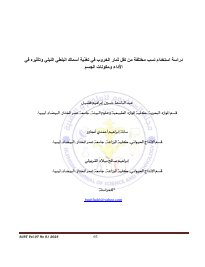Effects of Utilization Kibbled Carob By-Products on Growth Performance and Body Composition in Nile Tilapia (Oreochromis niloticus)
Keywords:
kibbled carob, Tilapia, Growth, body compositionAbstract
The feasibility of kibbled carob in the diet of Nile tilapia was evaluated in an 8-week feeding trial. four isonitrogenous and isocaloric diets with including kibbled carob (0, 2, 4, and 6%), 180 fish of initial weight 3.43±0.13 g were divided to 4 groups with triplicate, each replicate 15 fish. the Final weight, weight gain. specific growth rate and survival rate were not significantly different between all the groups. food conversion rate was significantly reduced at 2% kibbled carob inclusion compared to anther groups. fish moisture content, crude lipid and fiber were not significantly different between all experimental treatments. the protein significantly increased in fish fed 4% kibbled carob while crude ash significantly decreased in fish fed 2% kibbled carob The levels of triglycerides and cholesterol in the blood showed a significant decreased with the increase inclusion of kibbled carob in the experimental diets. Based on the results of the current study, it can be concluded that introducing kibbled carob as an effective non-traditional feed material in designing tilapia diets up to 4% of diet without any harmful effects on the performance and general health of the fish.


